Big Coffee
An in-depth review into the coffee “scene,” banks getting into the coffee game, third spaces, and does anyone work anymore?
A quick housekeeping note - Sugar Pills will be dosed into your inbox weekly, every Sunday.
Hopefully, this read ends your week better than it started.
This Wednesday, I had coffee with one of the various cool, employed people I’ve been cold emailing for the past week. She chose the spot - La Cabra, the new SoHo location. For those of you not in the city, and also for those of you in the city who have managed to avoid the sceney coffee culture firmly afoot, let me fill you in.
La Cabra (they are very famous, chic, and well known in Copenhagen, where they started in 2012) landed in the U.S. as a small pop-up in the space of a very scene-y restaurant called Gem, in NYC, that was started by - you guessed it -a very young, attractive, scene-y, savant chef named Flynn. A scene within a scene; there’s something there, maybe. La Cabra, in their early days, had one pastry (a really stunning cardamom bun) and various types of expensive, supposedly delicious (I’m not a coffee drinker; my genetics do not allow me to consume coffee in a fun way but rather in an all-day anxiety spiral type of way) exotic coffee varieties.
When their brick-and-mortar opened in the East Village in 2021, the hype was palpable (you can read the full Eater article on their launch here that includes a lot of coffee-specific lingo and details like how long they roast their beans for, why Nordic roasters are the best in the world, and more that is not relevant to me). I went to the store open in 2021, in a barely post-COVID world where watching 30 people line up in spitting distance of each other felt like a privilege. The East Village shop is austere - true to its Scandinavian roots. Metal counter tops, odd, slightly off-putting lyric-less music, baristas all wearing matching cream beanies and cream workwear jackets, nobody speaking above a whisper. The seating arrangement is very limited, with tables and chairs that one could argue are made for ages twelve and below. It all adds to the air of exclusivity and experience that firmly shouts in your face that you’re walking out of there with at least fifteen less dollars than you started with. The cardamom buns were, and have remained to be, the star of the show for those wondering.
To summarize, finding a seat at La Cabra is not for the faint of heart. For the record, finding a seat, or a reservation, or a building without a line in New York is not for the faint of heart. I had thought that my newly freed schedule would allow me to beat the crowds, and if not, at least have the time to wait out a table. How wrong I was, and continually am. I forgot that nobody works in this city but everyone is supposedly employed. Every single table, chair, windowsill, stool, you name it was filled. At 10 am on a Wednesday. I have no other option than to believe everyone in the Daytime Coffee Shop Crowd™ is sleeping with a barista but me.
The DCSC™ was out in full force that morning. I tried to snap some photos of the space without being too conspicuous; see below. I should have known that extra time was no match for people that liked to drink $12 coffees in sunglasses. I walked in at 9:30 and beelined for two open bar seats (if you could call them bar seats, they were stools in which the actual seat was so sunken into the ground it probably would have been more comfortable to sit on the floor.) I quickly sat, threw my bag on the other “stool” to reserve it, and immediately started looking around for an empty table.
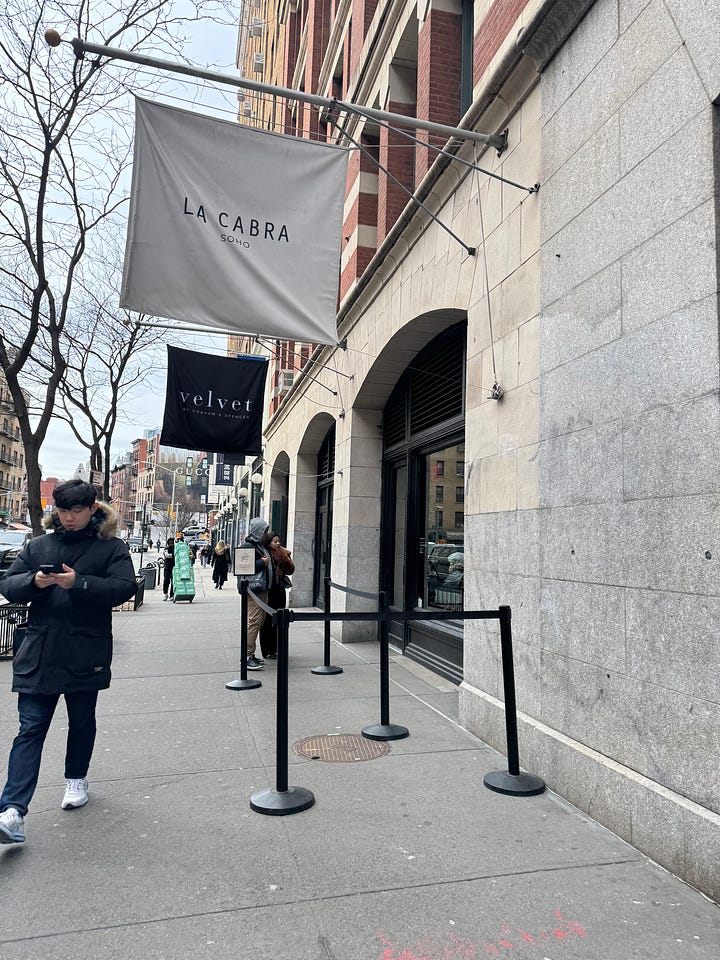
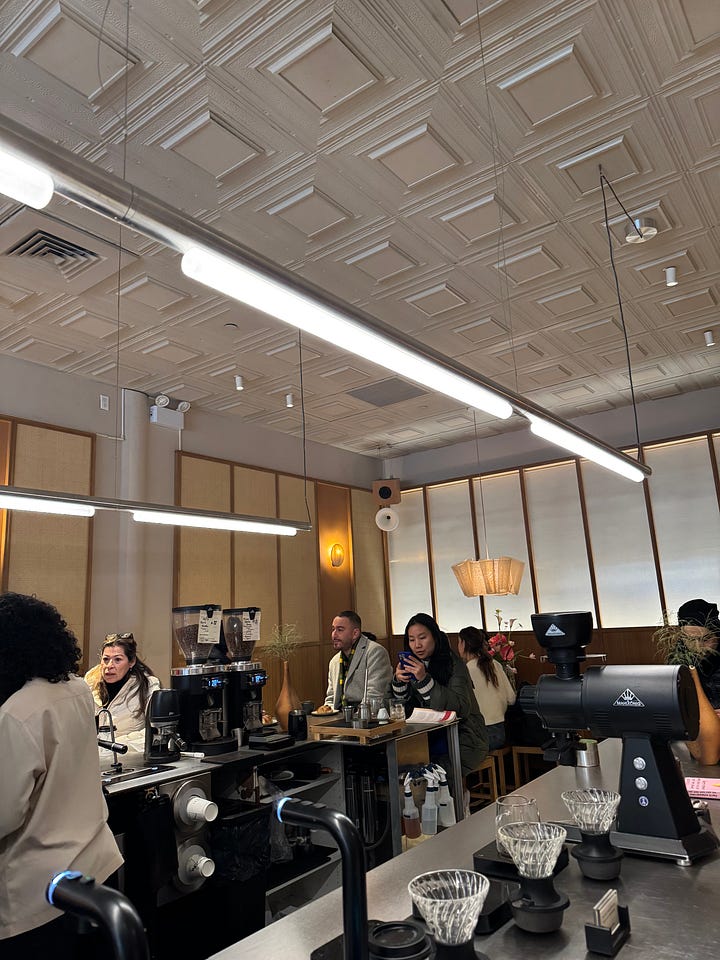
You may be asking yourself “but Sydney, you just said how hard it was to get ANY seat at all! Why are you complaining?” You’re right, one of my ten readers. Let me explain why I’m being ungrateful. Bar stools are not the way you want to meet a stranger. First - they’re uncomfortable, especially these stools, that probably came from some famous Danish coffee roaster’s house that were built by his Nordic, sea-faring grandfather and so on. Second - it’s twenty degrees outside. Where am I putting my monstrous down coat? And my bag? Obviously a shop like La Cabra does not have hooks underneath the counter; if you don’t look uncomfortable while consuming the coffee you’re not doing it right. Third - have you ever tried to cross your legs while sitting on a bar stool? You’re hunched over, your hands are under your chin, half your body is leaning onto the bar - it’s not a great look.
I reached for my computer, thinking maybe I would get some writing done (because I’m a writer now, two Substacks in) while I tried to scope out a better, less awkward seating situation. The second I pulled out my laptop and went to open it, one of the cream-colored beanies came over to me with such a look of pity I wondered if a bird had shit on my head without me realizing. “I’m sorry, we have a no-laptops policy here… if you could just put that away.” Obviously. Obviously, they had a no-laptop policy, who did I think I was, trying to do some semblance of something work-ish related in a place where it was sublimely mandated that nobody works? I smiled, said of course, and put away my laptop. The table situation now appeared more desperate than ever as I was in full view of everyone in the coffee shop who had just witnessed that debilitating interaction - I needed to hide. Out of the corner of my eye, I saw a table potentially opening. Right as I started to gather my belongings and sneak over, a man (duh) appeared seemingly out of nowhere, sat down, and started to draw on his iPad. I shot a look over to the cream beanie that was the perpetrator of my humiliation. He was oblivious as could be, making a matcha espresso syrup foam thing. Where are we drawing the line on what counts as a laptop? If the goal of a no-laptop policy is to foster an environment focused on intimate conversation and creativity, doesn’t this man using an Apple pencil to (most likely) steal someone’s design from the internet interfere with that? I slunk back over to my barstools, realizing I had lost the battle, but not the war as I ordered myself a cardamom bun as consolation.
Coffee culture, around the US but especially in places like LA and New York, has become insane. The rise of influencers and social media has only made this worse and more inaccessible, creating what I like to call Exclusive Coffee (influencers and their morning coffee runs… insufferable. Probably worth another newsletter on influencer culture, stay tuned.) I’ve crowdsourced some of the sceney-est, most annoying shops on both coasts from some of the most fun coffee snobs I know, and included the text messages here in case you want to try any of these at your own risk.
Beware of lines around the corner; influencers abound.
I was curious as to where the winnings from these $12 coffees were winding up, so I did some light research. In the case you’d like to limit your frontal lobe usage on a Sunday, I’ll summarize: the answer is another phrase I’m claiming development of, Big Coffee. Since the mid-2010s, VCs have been growing their investment in the coffee industry, a market that is expected to surpass $50 billion by 2030. Some of the most ubiquitous places are backed by men in suits rather than men in beanies - Blue Bottle (quick shoutout from my coffee-anxiety days to their Shakerato and Nola cold brew - addicting), Gregory’s Coffee, Philz, and perhaps the most well-known, well-memed of them all, Blank Street (which just reached a valuation of $98 million). It’s not just physical stores, either. Cascade Coffee received backing from PE firm LaSalle Capital, Arkansas-based drive-thru coffee chain 7 Brew Coffee received a chunk of investment from Blackstone, FairWave Specialty Coffee Collective is a PE-backed organization that has acquired numerous coffee brands across the Midwest since 2020. The rise of Big Coffee has a multitude of pros and cons, as does anything involving large sums of money and caffeine addictions. I won’t go into each argument here, as that is not the point of this newsletter and I am not educated enough in either field beyond previously enjoying these expensive sugar-milks to explain the nuances of investment into coffee. If you’re interested in learning more about the subject, The Pourover (coffee industry trade mag) did a really interesting deep dive into private equity and venture capital in the coffee industry that you can read here.
Coffee shops have always served as a strong community foothold, creating more wholesome rituals and environments than bars or restaurants. Sociologist Ray Oldenberg coined the concept of a “third place” - a place separate from the home, your first place, and work or school, your second place. I first learned of the term during COVID, where our third places ceased to exist and we were forced to create them in our backyards, balconies, or corner bodegas. As our society plummets towards increasingly hyper-personalized and robotic experiences (mobile ordering, ghost kitchens, letting our social media algos consume us), these third spaces are dwindling. Because of said hyper-personalized experiences, we probably don’t even notice their disappearance unless it directly affects us, like my inability to find space in a coffee shop in the tri-state area. (Here’s a great read from Vox on the importance of a third space that I liked.)
Coffee shops, arguably some of the most important and inclusive third spaces, have fallen wayside to exclusivity, influencer culture, and venture capital - a brutal combination contributing to the denigration of the third space. Exclusivity and efficiency as the means and the end are in, welcoming experiences are out. Which leads us to a concerning and hilarious offshoot of Big Coffee - Bank Coffee. And specifically within Bank Coffee, the Capital One Café.
Capital One saw Big Coffee pretending to keep the sanctity and ritual of coffee and they said “I’ll raise you building a coffee shop in my bank.” For months now, I’ve been staring at the Café— from the time it was being constructed to the day it opened its doors— on my walk to the subway. My equal parts confusion and fascination with the concept have kept me intrigued enough to dedicate an entire newsletter to a liquid I don’t even drink. My first thought about the Capital One Café was perhaps the most obvious— since when do banks make cafes? I didn’t really take it seriously, chalking it up to Big Coffee (but not yet Exclusive Coffee) and considered it to be another signal that our world was becoming increasingly more dystopian. Then, I started to do actual research into the COC (fun and apt abbreviation for brevity’s sake) and realized that this was no one-off— this was a chain.
From the source itself, “Capital One is reimagining banking—welcome to the Capital One Café! The idea is simple: Create a welcoming space where banking meets living. Where everyone can relax, refuel, and unwind, whether they're Capital One customers or not.” The webpage goes on to detail about the “Cafe Ambassadors” that seem to be part-time bank workers, part-time cafe managers, part-time… I honestly don’t really know; it’s either intentionally vague or meant for people much smarter than I am, or probably both. But if you really care, you can read more about the inception and the odd minions of COC workers here. (Imagine you walk into a COC after reading this newsletter, and there I am, greeting you with a name tag on. I hope you all have nightmares tonight of that visual.)
The first Café launched in New York almost twenty years ago. Now, there are more than 50 branch locations across 18 states. Customers of Capital One get 50% off cafe items; each Café is intentionally built with plenty of outlets, bright, open lighting, WiFi, and a door to the underworld. Kidding (maybe) but the cafes are connected to actual branches of the bank. The purpose behind the cafes, besides targeting a millennial audience with a coffee addiction, was to “give customers a chance to come in and experience the Capital One Brand in a real way.” What community and brand experience is a customer supposed to be connecting to? A stale croissant and their bad credit scores?
For the sake of investigative journalism (is that what we’re calling this now?) I decided to go try and write part of this within the belly of the beast. I’ve included photos of my experience for those of you who don’t have the desire or the access to visit a COC in person. The second you walk in, you are greeted by several of what I assume to be the Café Ambassadors. Lots of smiles, lots of name tags, lots of staring. Once - and if - you get past them, you are standing in a large space that looks like… a bank. A bank waiting area. Or a dentists office. Lots of low, uncomfortable couches, tables and chairs that look like they came from the set of a nondescript commercial on coffee shops. The barista counter featured signs for drinks like the “Hibiscus Bergamot Bowl of Soul” and food “All Day Favorites” such as the “Yogurt Power Bowl” and “Roasted Turkey Club.” As I looked around to reluctantly find a seat, I realized that Bank Coffee was Big Coffee was Exclusive Coffee. Every. Single. Seat. Filled. This is a BANK CAFE. There’s no way all of you are there opening credit cards! This is the environment you all wanted to spend your afternoon in, eating your Yogurt Power Bowls and thinking about mortgages? So I left, for the same reason why I had been leaving coffee shops all over the city for the past week. Although, on my way out I was tempted to order the “Bowl of Soul” to go, for the bit, but morally decided it against it. I’ve since made it a point to walk by the COC multiple times a day at various odd hours, and it’s the same story. Same smiling name tags, same filled to the brim uncomfortable couches. Turkey clubs amuck.
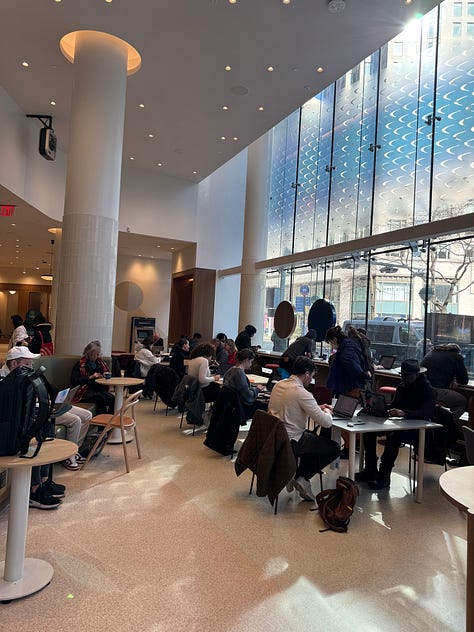
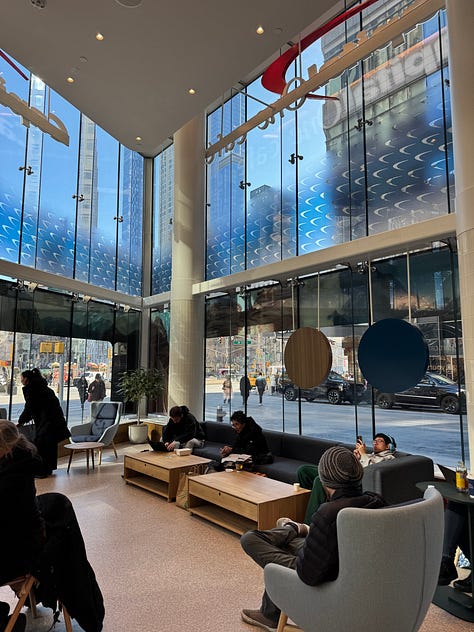
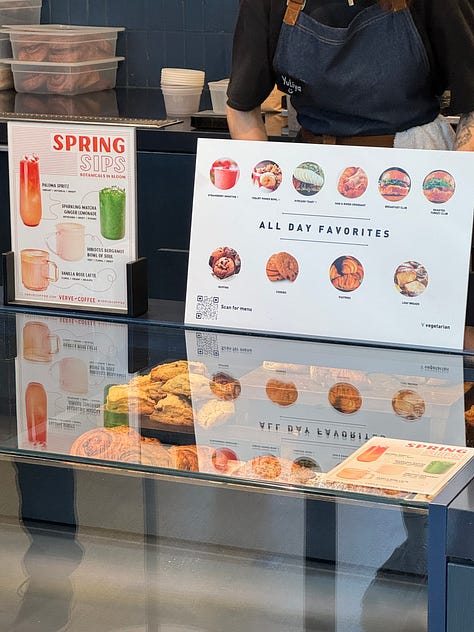
We have entered into an era of The Third Space 2.0. If we can’t even get seats at a Capital One Café, what does this mean for community engagement? For the future of human connection? What does it mean for us that banks are the ones filling these gaping holes with sponsored spaces, and doing a really good job at it? I’ll leave it to you all to answer these questions, if you’d like, as I fear my answers are too depressing to say out loud.
There’s a good chance that this problem is hyper local to cities whose cultures are primarily based upon consumption, and being seen while consuming. At least, I’d like to think so. Regardless, as our third spaces continue to evolve and change, some of them into something unrecognizable, I want to highlight that there are many beautiful, accessible, and meaningful third spaces still in existence. The 72nd street farmers market and the woman selling home-made kimchi there that I’ve befriended, the chess club I recently joined, Shabbat services at my synagogue that are open to all. I implore you to think of your favorite third spaces, and how you can support them from turning into checking-account coffee.
But for now, as I am at the mercy of the cool, employed people who enjoy coffee, you can find me consuming a cardamom bun or two and claiming scarce territory where I’m able. As I conclude this newsletter, I’m currently sitting in Cafe Lyria, one of the shops featured in the crowdsourced texts and by far one of the most exclusive and bitchiest. I thought it was only right to sit here, not order anything, and stare right on back at those trying to snag my table.






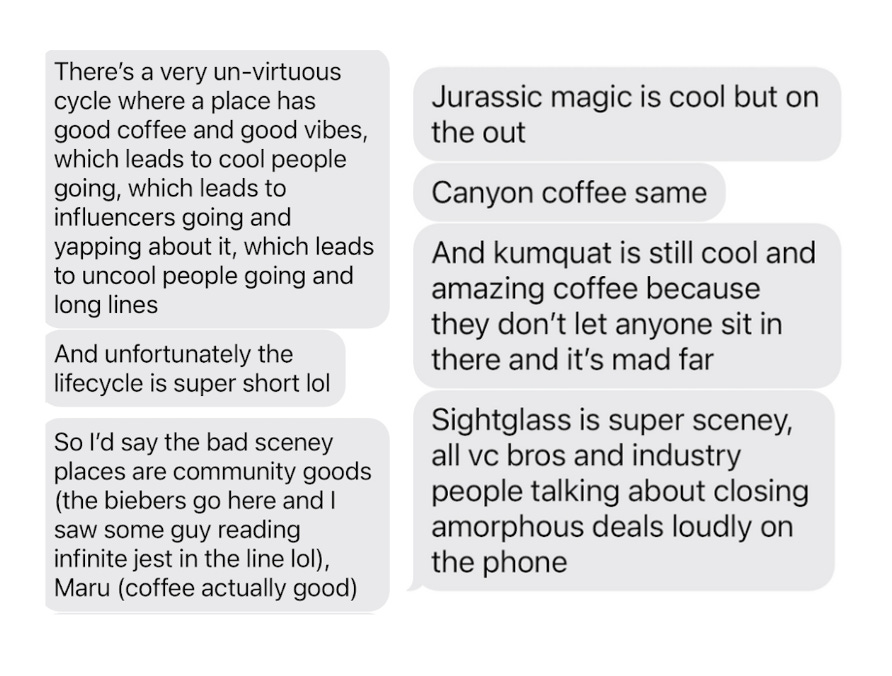
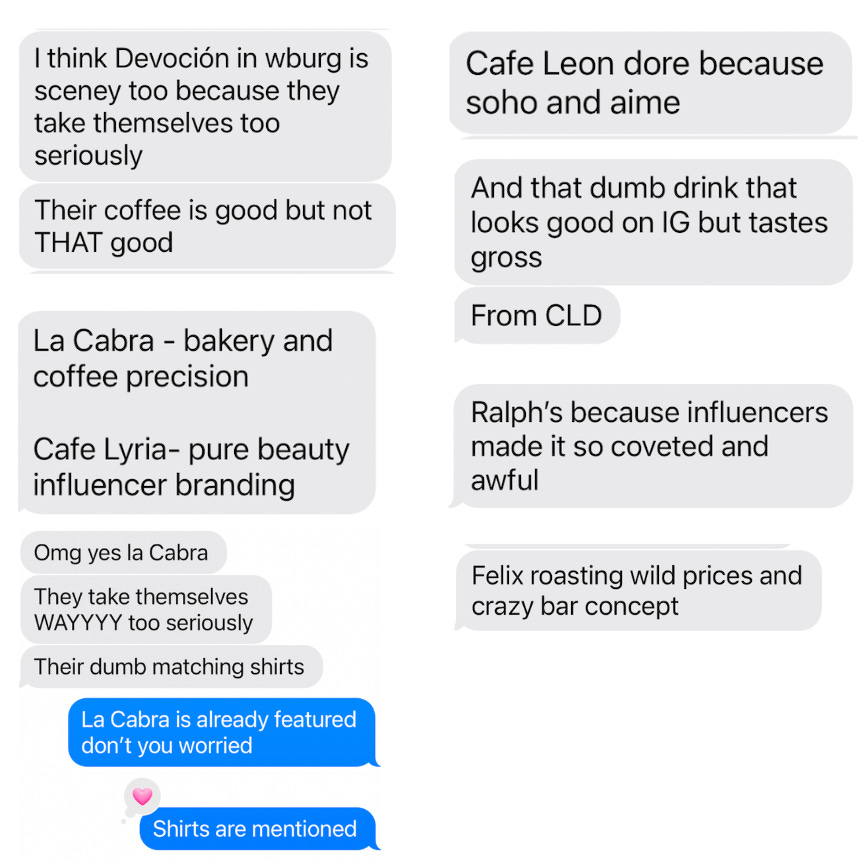
Brilliant!
4-star deconstruction of Big Coffee. (It could’ve been 5-star; if your LA friend has a better way for me to advertise I’m a pretentious white man, I’ll stop carrying Infinite Jest everywhere)